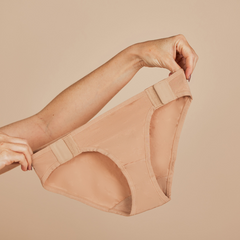When we think about libido, a lot of times we think about it as a light switch. I'm either turned on or I'm not. I'm either horny or I'm not. If this is what you are used to, it can feel really stressful to not feel that desire as easily or as frequently as you used to.
“Light Switch” desire is known as spontaneous desire, which is heavily dependent on hormones. During and post-menopause, the reduction in hormones can reduce libido and cause this type of desire to dwindle down to almost nothing. But there is hope in the other “Light Dimmer” desire known as responsive desire.

Spontaneous Desire & Responsive Desire
First, let us spend some time reviewing the different types of desire: spontaneous desire and responsive desire.
I like to use the following metaphor to explain spontaneous desire. You are in a movie theater, and it is pitch black, and on the black screen comes a flame. You do not know where the flame is coming from, you do not know the heat source, and you do not know how long it has been there. It is like an eternal flame.
That is spontaneous desire. It’s “I’m a light switch. I’m turned on and don’t even know why.” That is influenced a lot by hormones, so naturally that is a feeling that declines over time.
Then there is responsive desire or contextual desire. The metaphor I use for responsive desire is to imagine that you are at a campsite. There is a huge bonfire, and the bonfire has a lot of wood and kindling. You have lighter fluid. It is not raining. The campfire is ablaze! There are Adirondack chairs and all your favorite people are there. It is beautiful, the foliage is turning and the playlist is bumping.
This is what we call contextual or responsive desire. This means that the context that you are in and the way that your partner is interacting with you or the way you are interacting with your environment is what builds your desire.
Building Responsive Desire
There is not much we can do to influence spontaneous desire, but responsive desire is something we have a lot of control over.
So how do we facilitate responsive desire? Start with considering your unique and specific turn offs and turn ons. A lot of times, turn offs are going to be things like stress and not sleeping well. Body pain and aches. Getting bad news. People are more similar when it comes to turn offs then they are to their turn ons. People’s unique turn ons are so expansive and unique.
A lot of your turn ons might not necessarily be things that make you horny. When people think of turn ons, they often think of being horny. But no one ever gets to horny without passing through “Go.” Think about it as a scale of 0 to 10, where six is a “horny, excited, gotta have it feeling”.
Again, nobody gets to 6 without going through 1. So, think about activities you could do that help you move from a 0 to a 1, not a 0 to 6. Hence, the “light dimmer reference”, you’re slowly and incrementally turning yourself on.
When your partner initiates sex and you are at a 0 and you think you should be at a 6 in order to say “yes,” you're going to say no. If you don't know how to get to a 6, you’re going to shut down and decline. That’s why you need to think about what takes you from a 0 to a 1, a 1 to a 2, a 2 to a 3. And it’s in that one to three range where the magic can happen.
Remember, what’s on your list is totally unique to you. It’s typical for the activities in that 1- 3/10 range to be nonsexual. It might be taking a hot shower, feeling relaxed, or knowing there are clean sheets on the bed. Maybe it’s having a nice meal with your partner and laughing with them. Maybe it’s watching a comedy show or going on a walk - either alone or with a partner.
Now you’re getting to a 2, and from a 2 to a 3 is when your partner rubs your back or rubs your neck. Remember your 2 is unique to you. Maybe for you it’s a back rub while for someone else a back rub is a 7!
The task for you is to think about ways you can facilitate desire. You’re not looking at the 6, 7, and 8 turn-ons, but the 1, 2, and 3s.
If sex is initiated and you are at a one, which is “I don’t want sex, but I want to want sex,” that's a great place to be. Pause and think, “What do I want?” What is going to get you to one? ?Communicate that to your partner. Ask them to pour you a glass of wine or jump in the shower. Slowly build up to it.
Most men do not understand the process of aging for women. How can we educate them without making them feel like they're ignorant?
Whenever we are presenting information to our partners about something that we want, it’s helpful to address the limitation or the challenge and then offer parts of the solution. Bring them into the solutioning process. State how your body has changed, why it makes sex difficult, and why this makes sex different for you.
Try to be collaborative with them and bring them into the fold such that you can have a conversation where you say, “What do you think that we should do about this?” Then it becomes a way of working together versus just saying, here is my challenge.
Another thought is that sometimes we can hesitate to give feedback because we do not want to make our partner feel like an idiot. Re-frame that as helping your partner. Your partner needs all the help they can get and they would benefit from hearing explicitly how your body feels and how they can pleasure your body specifically.
A lot of times we have this idea that your partner should know what you want. Or that a person that is “good in bed” just knows “what women want” (as if all women want the same thing!). In reality, you are unique in what you want and this needs to be a conversation.
Your partner needs all the instruction and the direction that they can get to understand your body, and that is a very normal thing. You have to advocate for yourself and share what you want and like, especially the more nuanced bits. For example, the type of pressure or movement you enjoy. And those nuances change throughout your life. It's a fluid thing.
What is the best sex position during menopause?
It depends on what specifically feels uncomfortable, but a lot of times during menopause the labia minora and the labia majora become smaller, and so there is less cushioning right at the opening of the vaginal canal.
Positions that are particularly good are positions where your legs are closer together. When your legs are closer together, it elongates the vaginal canal by bringing the labia minora and labia majora together. It makes it such that the area being penetrated is a little bit longer, so there is more cushioning.
Try having sex with your legs together to be more comfortable. That could be sidelining, standing, doggy with your legs together.
I'm struggling to get wet. What can I do?
Desire is the “want” to have sex, while arousal is a cognitive experience. It is the enjoyment of sex. A lot of times we think arousal happens between our legs, but it is a cognitive experience where the brain says, “This is fun. I'm enjoying this.”
Lubrication is a sexual response. It's an automatic or autonomic sexual response we have. You cannot will it. We have very little control over it because it is a physiological process.
It is really finicky and does not listen to our brain, meaning you can be really aroused and having fun, but not necessarily lubricating. Conversely, you can lubricate without even being aroused.
When your body is not cooperating, add over the counter lubrication. Do not be afraid to use it. Use it throughout foreplay, before penetration, and during penetration if needed.
The other suggestion is to make sure that you are doing the activities that you find arousing. There is a higher likelihood that it will result in that sexual response of lubrication. It's not 100% guaranteed, but you have a much higher likelihood. You can also get some items to increase your comfort during sex if that’s part of the problem.
A lot of times there is an expectation that the body will quickly lubricate the second that the sexual process starts. That is not realistic and it is just not the way female bodies work.





